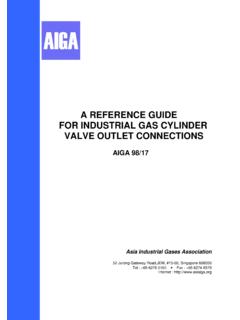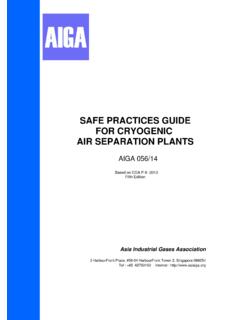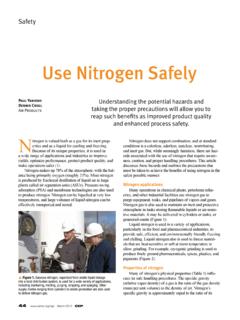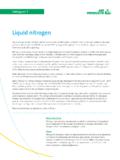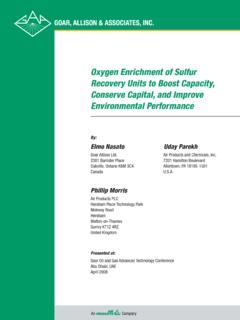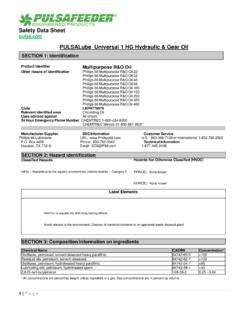Transcription of CODE OF PRACTICE NITROGEN TRIFLUORIDE - …
1 code OF PRACTICE NITROGEN TRIFLUORIDE AIGA 029/10 GLOBALLY HARMONISED DOCUMENT Asia Industrial Gases Association 3 HarbourFront Place, #09-04 HarbourFront Tower 2, Singapore 099254 Tel : +65 62760160 Fax : +65 62749379 Internet : Reproduced with permission from the European Industrial Gases Association. All rights reserved. ASIA INDUSTRIAL GASES ASSOCIATION 3 HarbourFront Place, #09-04 HarbourFront Tower 2, Singapore 099254 Tel : +65 6276 0160 Fax : +65 6274 9379 Internet : AIGA 029/10 GLOBALLY HARMONISED DOCUMENT code OF PRACTICE NITROGEN TRIFLUORIDE PREPARED BY : Jean-Paul Barbier Air Liquide Giorgio Bissolotti Siad/Praxair Kevin Cleaver Linde Jean-Claude Goffinet Air Products Bernard Hussler Messer France Pierre Wolfs EIGA Disclaimer All technical publications of AIGA or under AIGA s name, including Codes of PRACTICE , Safety procedures and any other technical information contained in such publications were obtained from sources believed to be reliable and are based on technical information and experience currently available from members of AIGA and others at the date of their issuance.
2 While AIGA recommends reference to or use of its publications by its members, such reference to or use of AIGA s publications by its members or third parties are purely voluntary and not binding. Therefore, AIGA or its members make no guarantee of the results and assume no liability or responsibility in connection with the reference to or use of information or suggestions contained in AIGA s publications. AIGA has no control whatsoever as regards, performance or non performance, misinterpretation, proper or improper use of any information or suggestions contained in AIGA s publications by any person or entity (including AIGA members) and AIGA expressly disclaims any liability in connection thereto. AIGA s publications are subject to periodic review and users are cautioned to obtain the latest edition.
3 AIGA 029/10 Acknowledgement This document is adopted from the European Industrial Gases Association document IGC Doc 092/10 code of PRACTICE NITROGEN TRIFLUORIDE . Acknowledgement and thanks are hereby given to EIGA for permission granted for the use of their document. AIGA 029/10 Table of Contents 1 1 2 Scope and 1 3 1 4 Gas properties .. 2 Gas 2 Physical 2 Chemical 3 Toxicology .. 4 Environmental 4 5 Gas major hazards .. 4 Introduction to fire and explosion hazards .. 4 Factors influencing combustion NF3 considerations .. 5 NF3 pressure ..5 NF3 decomposition temperature .. 5 NF3 velocity in 5 Factors influencing combustion - Material considerations .. 5 Auto-ignition temperature of 6 Self propagation of ignition of metals.
4 6 Specific heat of 6 Thermal conductivity of materials .. 7 Heat of combustion of materials .. 7 Size and configuration of equipment .. 7 Quantity of Cleanliness of equipment .. 7 Other Factors influencing combustion energy source .. 7 Particle 7 Mechanical shocks .. 8 Adiabatic 8 Flow 8 Mechanical friction of equipment moving parts .. 8 6 Gas handling equipment general considerations .. 8 Design 8 Materials of construction .. 8 Gas 9 Cleaning and passivation after installation and 9 Valves .. 9 Filters .. 9 Operating procedures and Personnel .. 10 Maintenance procedures .. 10 Separation from flammable gases .. 10 Heat dissipation .. 10 Compression .. 10 7 Gas Cylinder filling .. 11 Filling facility considerations .. 11 Gas containers and associated 11 Cylinders, tubes and bundles.
5 11 Cylinder Cylinder filling Cylinder filling equipment .. 13 Filling manifold .. 13 Vacuum pumps .. 13 Pressure 13 AIGA 029/10 8 Gas supply to point-of-use .. 14 Facility 14 Gas supply 14 Operating procedures and personnel .. 14 9 Gas abatement 15 Basic principles of abatement .. 15 Abatement - semiconductor process tool exhaust system .. 15 Abatement at a cylinder filling facility .. 15 10 Emergency 15 Appendix 1: References .. 16 Appendix 2: EIGA Material Safety Data 17 Appendix 3: Audit 21 AIGA 029/10 11 Introduction NITROGEN TRIFLUORIDE is an oxidizing compressed gas that has gained acceptance in a number of applications as a fluorinating agent. It is this property that makes it valuable as a non-reactive source of Fluorine for etching and cleaning applications.
6 The active Fluorine is released only if sufficient energy is applied. Once initiated, the reaction is self propagating and presents a hazard for a material that is incompatible with Fluorine. ( Flammable Gas, Metals). NITROGEN TRIFLUORIDE , can be safely handled if equipment is properly designed and appropriate handling precautions are taken. This document has been prepared in 2003 by the European Industrial Gas Association, with the assistance of the Compressed Gas Association & the Japanese Industrial Gas Association. The first 5-yearly revision in 2009 incorporated updates of the references to the other codes of practices that have been revised in the meantime. It has been further revised in 2009 to incorporate a few editorial modifications proposed by CGA during the 5 year review of their document G-14.
7 NOTE This document shall be used in conjunction with IGC doc. 30/07 Disposal of Gases code of PRACTICE , AIGA 004/04 Handling Gas Container Emergencies , AIGA 021/05 Oxygen Pipeline systems 2 Scope and Purpose Because of its widespread use and its potential for mishandling, this code of PRACTICE has been written and is intended for the Suppliers, Distributors and Users of NITROGEN TRIFLUORIDE and its handling equipment. It sets out to provide a good understanding of the potential hazards involved in handling NITROGEN TRIFLUORIDE and the approach to be taken to minimise the risk of incidents. The manufacture, purification and analysis of NITROGEN TRIFLUORIDE are beyond the scope of this document, although the general guidance given is also relevant to these processes.
8 Within the Annexes of this document are list of references, the EIGA Safety Data Sheet and audit check-lists. 3 Definitions Auto-ignition temperature: The temperature at which a substance will spontaneously ignite in a specified oxidant at a given pressure. Bundle: A group of cylinders which are manifolded together with a common valve connection for filling and use. Bundles are securely mounted in a frame for transport, storage and use and typically contain from four to thirty cylinders. Cylinder: For the purposes of this document, a cylinder is defined as a transportable container of up to 150 litres water capacity that can be filled with gas under pressure. Cylinder recovery vessel: Commonly known in the gas industry as cylinder coffin . A pressure vessel which is designed to safely contain a cylinder and its content for transportation and storage, until it can be safely emptied.
9 A cylinder recovery vessel is often fitted with a gauge to indicate internal pressure and with valves to enable purging. Decomposition temperature of NF3: The temperature at which NF3 begins to decompose into other more reactive species such as fluorine. Filling ratio: Sometimes known as filling degree or filling factor. The amount of a gas that can safely be filled into a cylinder without over-pressurisation of the cylinder under all anticipated ambient conditions. The filling degree (f) (prescribed in ADR, the European Road Transport Regulations) is expressed as the ratio: (M/C), Where: M = mass of gas filled (Kg) C = cylinder water capacity (Litres) AIGA 029/10 2 Gas cabinet: A locally ventilated enclosure designed to contain a gas supply cylinder and, where appropriate, an associated purge gas supply cylinder.
10 The term gas cabinet also includes the gas supply handling equipment such as purge manifolds and process gas pressure reducing regulators and control systems. The gas cabinet can be quite complex in design, often being equipped with automatic microprocessor control. NF3: Chemical formula for NITROGEN TRIFLUORIDE . Oxipotential: The oxidizing power of a gas compared to that of oxygen, given as a dimensionless number, where oxygen = 1 (ref: BAM STP1395 on oxidizing ability of gases) Passivation: For the purposes of this document, passivation is a procedure that is applied where there is a possibility of a reaction between a reactive gas and the container or system into which it is going to be introduced. Passivation ensures that any residual contaminants will react in a controlled manner and will create an inert fluoride layer.







